I have a Castleton wood stove from Hearthstone installed about 9 months ago. It originally had that beautiful greenish-gray color to it, but over the past several months it has been gradually turning orange. The stove is in a 3-season porch, so it is exposed to the outside air, however it does not get any direct contact with sun or rain. Sometimes it will get condensation on it if there's a lot of dew outside. One more detail. I coated the surface in mineral oil several months ago to help condition the surface. The obvious answer at first is it is rust stains, but there seems to be several different things going on.
1. When I first got it, there was already an orange-ish discoloration on one of the panels. I originally assumed this was just a natural color variation, and let it be. This is right from the factory, so I seriously doubt that was a rust stain. However, the discoloration that has propagated all over the stove since then seems similar in appearance.
2. There are two very dark orange stains on the top surface. These are the most likely candidates for being rust stains, but they seem pretty extreme to me. In the interest of full disclosure, I did have a wrought iron steam kettle that I used to put on the stove, but the spot where I used to put it is in the vicinity, but not exactly the spot where that orange stain is. Also, the kettle was mostly there last winter. It has not been on top of the stove all spring and summer (when the orange really seems to have emerged). I also had a magnetic thermometer on top of the stove. It was roughly in the vicinity, but not exactly on the spot with the smaller orange stain. See the attached pictures "overview" and "close up stain".
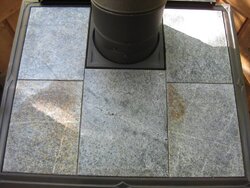
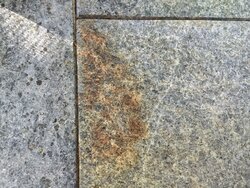
but there's more...
3. In addition to those two obvious stains, there seems to be a growing, diffuse orange discoloration on all surfaces of the stove. Sometimes the discoloration is in patches, and other times its more spread out. See the attached photo "left side" and the photo "spots" for a couple examples of patchy discoloration.
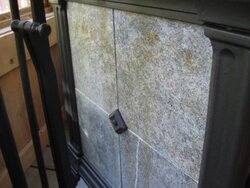
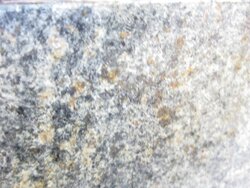
4. Even in the areas where there isn't any patchy discoloration, there is a subtle, diffuse orange discoloration that is gradually getting darker. If you look closely, it doesn't look like a surface discoloration, but a more "embedded" color change. Take a look at the photo "darkening flecks". Spots that were pure white now have an orange tint to them (the entire surface pretty much looks like this).
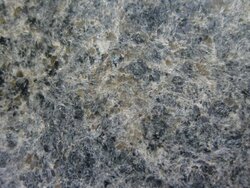
5. **Also take a look at the photo "subtle" for another example where all the spots that used to be green are now orange-ish, but the spots in between are still perfectly white. If this were just a surface rust stain, I would expect the whole surface to be discolored. Instead, only the parts there used to be green/gray in this photo have become discolored, while all of the parts that were originally white are still white. Its as if only certain minerals/elements within the stone are becoming discolored.
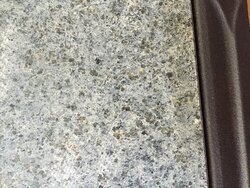
My first question is what is happening here? At first it seems like its obviously rust, but that isn't consistent with everything that's going on (such as the entire surface taking on an orange hue).
Second question is how do I get rid of it? Can I scour it away with sandpaper and then later smooth out and polish the surface again? (I suspect I may end up just ruining the whole thing if I try this).
1. When I first got it, there was already an orange-ish discoloration on one of the panels. I originally assumed this was just a natural color variation, and let it be. This is right from the factory, so I seriously doubt that was a rust stain. However, the discoloration that has propagated all over the stove since then seems similar in appearance.
2. There are two very dark orange stains on the top surface. These are the most likely candidates for being rust stains, but they seem pretty extreme to me. In the interest of full disclosure, I did have a wrought iron steam kettle that I used to put on the stove, but the spot where I used to put it is in the vicinity, but not exactly the spot where that orange stain is. Also, the kettle was mostly there last winter. It has not been on top of the stove all spring and summer (when the orange really seems to have emerged). I also had a magnetic thermometer on top of the stove. It was roughly in the vicinity, but not exactly on the spot with the smaller orange stain. See the attached pictures "overview" and "close up stain".


but there's more...
3. In addition to those two obvious stains, there seems to be a growing, diffuse orange discoloration on all surfaces of the stove. Sometimes the discoloration is in patches, and other times its more spread out. See the attached photo "left side" and the photo "spots" for a couple examples of patchy discoloration.


4. Even in the areas where there isn't any patchy discoloration, there is a subtle, diffuse orange discoloration that is gradually getting darker. If you look closely, it doesn't look like a surface discoloration, but a more "embedded" color change. Take a look at the photo "darkening flecks". Spots that were pure white now have an orange tint to them (the entire surface pretty much looks like this).

5. **Also take a look at the photo "subtle" for another example where all the spots that used to be green are now orange-ish, but the spots in between are still perfectly white. If this were just a surface rust stain, I would expect the whole surface to be discolored. Instead, only the parts there used to be green/gray in this photo have become discolored, while all of the parts that were originally white are still white. Its as if only certain minerals/elements within the stone are becoming discolored.

My first question is what is happening here? At first it seems like its obviously rust, but that isn't consistent with everything that's going on (such as the entire surface taking on an orange hue).
Second question is how do I get rid of it? Can I scour it away with sandpaper and then later smooth out and polish the surface again? (I suspect I may end up just ruining the whole thing if I try this).


 this is not a dull Woodstock but a mirror finished hearthstone. You'll ruin the stone's glossy finish with steel wool.
this is not a dull Woodstock but a mirror finished hearthstone. You'll ruin the stone's glossy finish with steel wool.